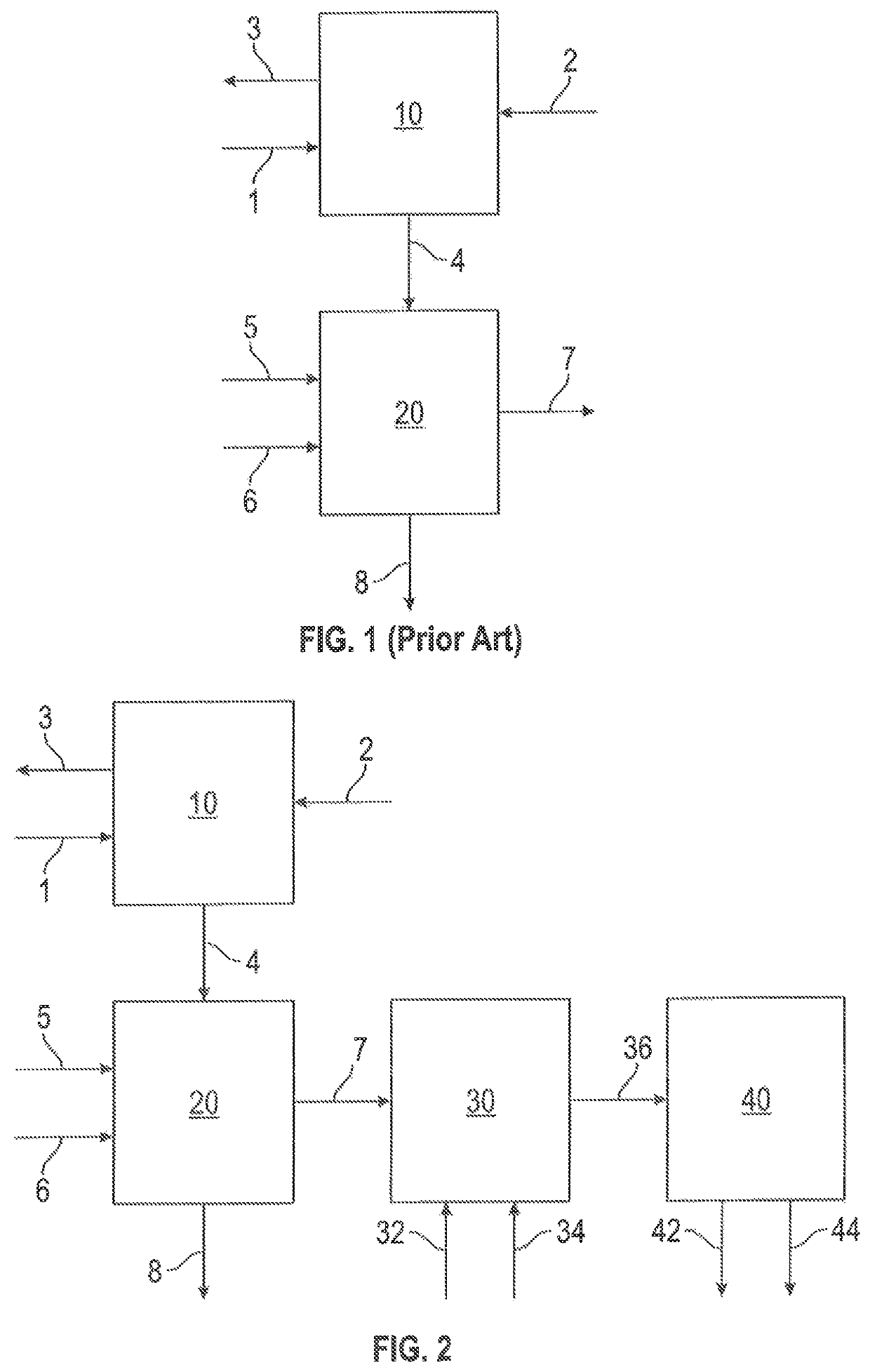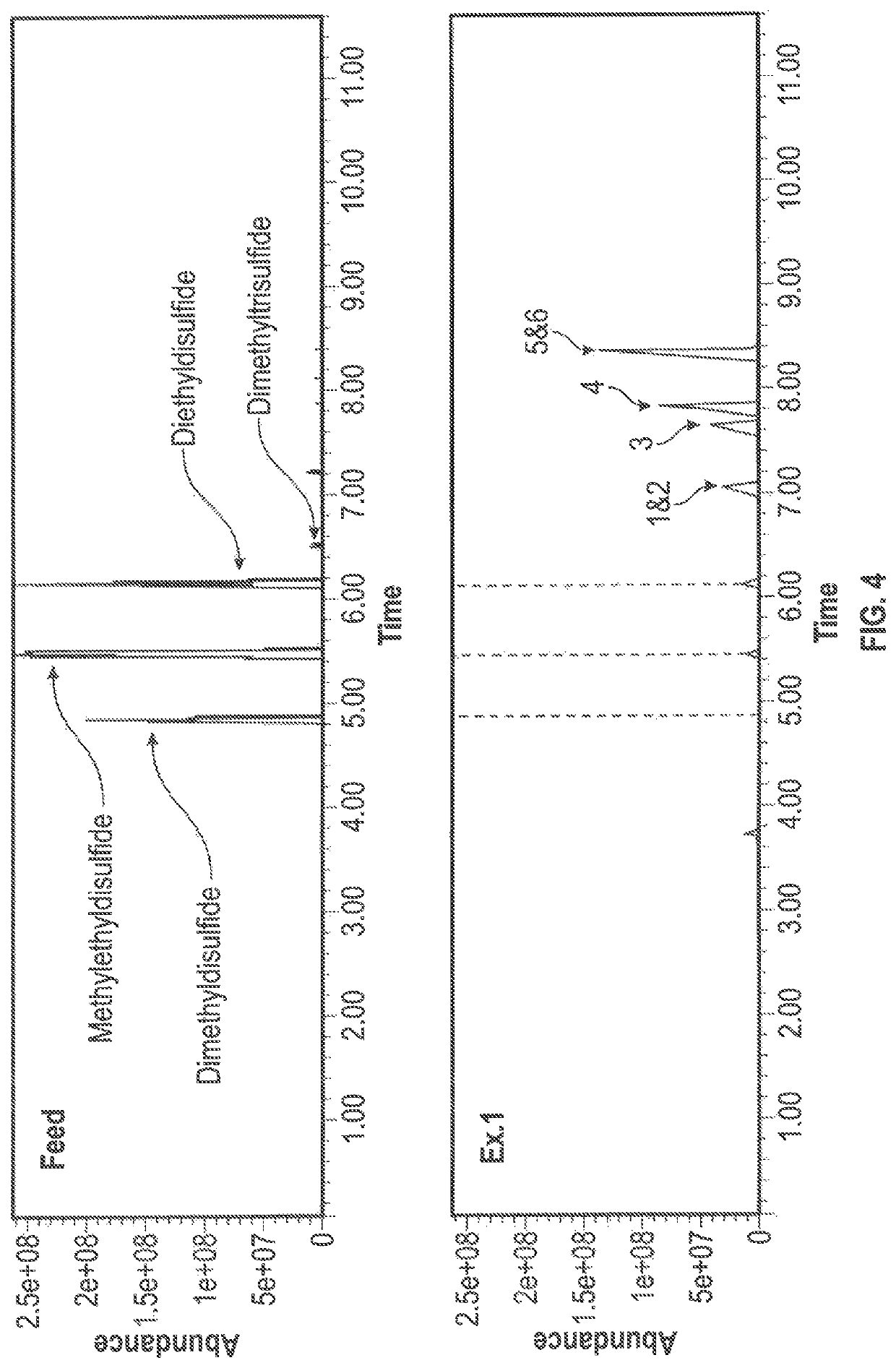Controlled catalytic oxidation of MEROX process by-products in integrated refinery process
a technology of merox process and by-products, applied in the direction of physical/chemical process catalysts, separation processes, refining with aqueous alkaline solutions, etc., can solve the problems of disulfide oil having an unpleasant foul or sour smell, difficult disposal of disulfide oil,
- Summary
- Abstract
- Description
- Claims
- Application Information
AI Technical Summary
Benefits of technology
Problems solved by technology
Method used
Image
Examples
example 1
[0047]An oxidation reaction was conducted using disulfide oil compounds that were obtained from a propane and butane MEROX unit. The following were added to a stirred reflux flask: 25.54 g of disulfide oil (R—S—S—R) reactant, 99.15 g of hydrogen peroxide (H2O2) oxidant, 12.2 g of acetic acid (CH3COOH) phase transfer agent, and 0.23 g of sodium tungstate (Na2WO4.2H2O) catalyst which were reacted under reflux at 80° C., with stirring at 400 rpm and the condenser set at 10° C. The reflux was discontinued after 1 hour and, following settling, the clear separation of a water insoluble oil phase and a water soluble oil phase was observed. The water soluble oil phase was rotary evaporated under reduced pressure at 90° C. to recover the product oil. The water insoluble products were subjected to a GC-MS analysis and analyzed for density and sulfur content, and simulated distillation data was prepared. It is noted that the polarity of the more highly oxidized water soluble products precludes...
example 2
[0058]An oxidation reaction was conducted under the same conditions as reported in Example 1, with the exception that compositional changes were made to increase the ratio of the oxidant to the disulfide oil. The composition of the feed is the same as that reported for the feed of Example 1. The following were added to a stirred reflux flask: 20.05 g of disulfide oil (R—S—S—R) reactant, 100.03 g of hydrogen peroxide (H2O2) oxidant, 9.6 g of acetic acid (CH3COOH) phase transfer agent, and 0.22 g of sodium tungstate (Na2WO4.2H2O) catalyst. The reaction proceeded under the same conditions as in Example 1. The two phases were separated after the reflux was discontinued and the water soluble ODSO in the aqueous phase was rotary evaporated under reduced pressure at 90° C. to recover the product oil. The water insoluble products were subjected to GC-MS analysis, and also analyzed for density and sulfur content. Simulated distillation data was prepared. Table 5 summarizes the material balan...
example 3
[0068]An oxidation reaction was conducted under the same conditions as reported in Example 1, with the exception that compositional changes were made to further increase the ratio of the oxidant to the disulfide oil. The following were added to a stirred reflux flask: 17.45 g of disulfide oil (R—S—S—R) reactant, 105.05 g of hydrogen peroxide (H2O2) oxidant, 8.39 g of acetic acid (CH3COOH) phase transfer agent, and 0.19 g of sodium tungstate (Na2WO4.2H2O) catalyst. The reaction proceeded under the same conditions as in Example 1. After the reflux was discontinued, only a water soluble oil phase was found and the product was rotary evaporated under reduced pressure at 90° C. to recover the product oil. Due to its high polarity, the product could not be subjected to GC-MS analysis, but was analyzed for density and sulfur content, and simulated distillation data was prepared. Table 7 summarizes the material balance for Example 3.
[0069]
TABLE 7Amount, gReactants / AgentsCatalyst0.19Acetic A...
PUM
| Property | Measurement | Unit |
|---|---|---|
| molar ratio | aaaaa | aaaaa |
| pore diameter | aaaaa | aaaaa |
| pore diameter | aaaaa | aaaaa |
Abstract
Description
Claims
Application Information
 Login to View More
Login to View More - R&D
- Intellectual Property
- Life Sciences
- Materials
- Tech Scout
- Unparalleled Data Quality
- Higher Quality Content
- 60% Fewer Hallucinations
Browse by: Latest US Patents, China's latest patents, Technical Efficacy Thesaurus, Application Domain, Technology Topic, Popular Technical Reports.
© 2025 PatSnap. All rights reserved.Legal|Privacy policy|Modern Slavery Act Transparency Statement|Sitemap|About US| Contact US: help@patsnap.com



